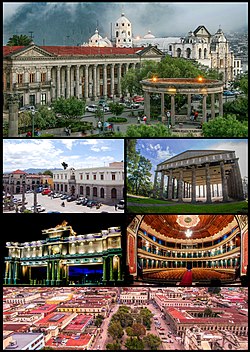
Back كويتزالتنانغو Arabic كويتزالتنانجو ARZ Kecaltenangs BAT-SMG Кесальтэнанга Byelorussian Кецалтенанго Bulgarian Quetzaltenango Breton Quetzaltenango Catalan Municipio de Quetzaltenango CEB Quetzaltenango Czech Quetzaltenango Danish
Quetzaltenango
Xelajú (K'iche') | |
|---|---|
Municipality and city | |
 Historical buildings, Streets, Minerva Temple, Arch sixth state of Los Altos, Interior of Municipal Theater and Historical center. | |
| Coordinates: 14°50′40″N 91°30′05″W / 14.84444°N 91.50139°W | |
| Country | |
| Department | |
| Spanish foundation | 15 May 1524 |
| Government | |
| • Type | Municipality |
| • Mayor | Juan Fernando López, Partido Humanista |
| Area | |
• Municipality and city | 122 km2 (47 sq mi) |
| Elevation | 2,330 m (7,640 ft) |
| Population (2018 census)[1] | |
• Municipality and city | 180,706 |
| • Density | 1,500/km2 (3,800/sq mi) |
| • Urban | 180,706 |
| Demonym | Quetzalteca/o |
| Time zone | UTC-6 (Central America) |
| Climate | Oceanic climate: subtropical highland variety (Cwb) |
Quetzaltenango (Spanish pronunciation: [keˌtsal.teˈnaŋ.ɡo], also known by its Maya name Xelajú [ʃelaˈχu] or Xela [ˈʃela]) is a municipality and namesake department in western Guatemala. The city is located in a mountain valley at an elevation of 2,330 meters (7,640 feet) above sea level at its lowest part. It may reach above 2,400 m (7,900 ft) within the city.
As of 2018, the city has a population of 180,706. 43% of the population was indigenous in 2014.[3] The Municipality of Quetzaltenango consists of an area of 122 km2 (47 sq mi). Municipalities abutting the municipality of Quetzaltenango include Salcajá, Cantel, Almolonga, Zunil, El Palmar, Concepción Chiquirichapa, San Mateo, La Esperanza, and Olintepeque in Quetzaltenango department and San Andrés Xecul in Totonicapán department.
- ^ Citypopulation.de Population of departments and municipalities in Guatemala
- ^ Citypopulation.de Population of the major cities in Guatemala
- ^ CORREDOR ECONÓMICO Quetzaltenango-Huehuetenango/La Mesilla
© MMXXIII Rich X Search. We shall prevail. All rights reserved. Rich X Search
